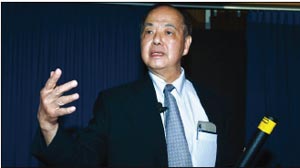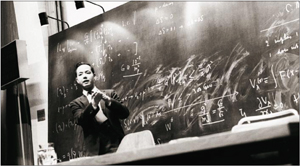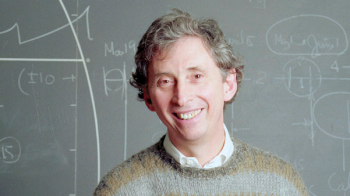Symmetry and particles, 50 years after the discovery of parity violation.
On 10 December 1957, two young Chinese-Americans arrived in Stockholm to collect the Nobel Prize in Physics – the first Chinese to achieve this award. Tsung-Dao Lee and Chen Ning Yang received their share of the best-known prize in science for work done in the summer of 1956, in which they proposed that the weak force is not symmetric with respect to parity – the reversal of all spatial directions. The bestowal of the Nobel was a fitting end to a tumultuous year for physics, which began with results from an experiment on nuclear beta-decay in which Chien-Sung Wu and collaborators had shown that Lee and Yang were correct: nature violates parity symmetry in weak interactions.

Half a century later, Lee continues to focus on understanding the basic constituents of matter and, in particular, symmetry in fundamental particles, though much has changed in the intervening years. “Our concept of what matter is made of, 50 years later, is very different,” he points out. “Today, we now know that all matter is made of 12 particles: six quarks and six leptons. The constituents of all matter – not dark matter, not dark energy but our kind of matter – every star, our Milky Way, all the galaxies in the universe are made of these 12.”
These 12 particles, divided into four families, each with three particles of the same charge, form the basis of the current Standard Model of particle physics. They are what students first learn about the subject. In 1957, however, physicists had a clear knowledge of only two of these – the electron and the muon, both charged leptons. Quarks lay in the future, and the neutrino associated with nuclear beta-decay had been detected for the first time only the previous year. Since then, the field has blossomed with the discovery of a total of six kinds of quark, a third charged lepton (the τ) and three kinds of neutrino. Five decades ago, Lee explained: “We knew a form of neutrino, but we didn’t know how to make a coherent mixture of all these three.” Now, one of Lee’s main interests lies in the phenomenon of mixing in the leptons and quarks, described by two 3 × 3 matrices, which he calls the cornerstones of particle physics.
Lee is fiercely proud of the progress in particle physics, and believes that the second half of the 20th century was as rich as the latter part of the 19th century. The 1890s saw the discovery of the electron, and Ernest Rutherford opened the door to a new world with his work on alpha, beta and gamma radiation. Here already, Lee observes, was much of 20th-century physics – alpha, beta and gamma decay, respectively, occur through the strong, weak and electromagnetic interactions, which underpin the Standard Model. “Now, 100 years later, we realize that all of our kind of matter is made of 12 particles, divided into four families, each of three particles of the same charge – that is fantastic.” He believes that the field is poised to lead to more great physics out of a better understanding of these basic constituents.
Lee’s contributions to particle physics during the past 50 years have been equally impressive. Growing up in China, he proved to be an excellent student and in 1946 he was able to go to the University of Chicago on a Chinese government scholarship. He gained his PhD under Enrico Fermi in 1950 and in 1953 was appointed assistant professor of physics at Columbia University, where he remains an active member of the faculty. His work in particle physics ranges from the ethereal, almost insubstantial world of the weakly interacting neutrinos to the rich, dense soup of the strongly interacting quark–gluon plasma.
At Columbia in the late 1950s, Lee’s enthusiasm for studying weak interactions at higher energies than in particle decays helped to inspire an experimentalist colleague, Melvin Schwartz, to work out how to make a beam of neutrinos. This led to the famous experiment at Brookhaven National Laboratory in 1962, which showed that there are two different neutrinos associated with the electron and the muon. Two years later, Brookhaven was again the scene of a groundbreaking experiment, when James Cronin, Val Fitch and colleagues discovered that the combined symmetry of charge-conjugation and parity (CP) is violated in the decays of neutral kaons. This phenomenon was eventually understood in the context of six kinds of quark and their 3 × 3 mixing matrix – a major focus of Lee’s current work.

At around this time, Lee also made a seminal contribution to field theory, which would ultimately be an important part of QCD, the theory of strong interactions. What is now known as the Kinoshita–Lee–Nauenberg theorem deals with a problem of infrared divergences in gauge theories. In QCD, this underlies our understanding of the production of jets from quarks and gluons – a topic of key importance at particle colliders, from the early days of SPEAR at SLAC to the LHC, about to start up at CERN.
However, it is in the physics of hot, dense QCD matter in the form of a quark–gluon plasma that Lee has made one of his most important marks, pushing people to realize that it was indeed possible to observe this exciting new state of matter. In 1974, at a time when experimentalists were concentrating on smaller and smaller scales, he put forward the idea that “It would be interesting to explore new phenomena by distributing high energy or high nuclear density over relatively large volume.” In particular, he saw the possibility of restoring broken symmetries of the vacuum in collisions of heavy nuclei. This was one of the inspirations behind those who pushed for the RHIC collider at Brookhaven, and Lee witnessed the results emerging on strongly interacting quark–gluon plasma during the past few years with excitement. He also sees a possible link between the physics of heavy-ion collisions and the physics of dark energy. Both could involve a collective field – a scalar – that in the presence of a matter field can generate a negative pressure. “I believe the heavy-ion programme at the LHC will be very important to explore this possibility.”
During Lee’s recent visit to CERN, he saw the enormous effort now going into preparations for the LHC. So what does he think the experiments there will find? While he expects the LHC to make important discoveries, including evidence for new particles such as the Higgs boson, his continuing thoughts about symmetry in the universe lead to more personal predictions.

He believes that asymmetries in parity, charge conjugation and time reversal are not asymmetries of the fundamental laws of physics. Instead, he thinks it is likely that they are “asymmetries of the solutions, namely the Big Bang universe we live in – it is the solution that is not symmetrical”. In other words, he sees CP violation as an effect of spontaneous symmetry-breaking. In this case, says Lee, there is a possibility of finding right-handed W and Z particles to match the left-handed Ws and Z already known. Other new particles could be massive partners for the massless graviton, just as the massless photon has heavy partners in the W and Z. “They will have to be uncovered, and the LHC might also be the first window on that.”
The promise that the LHC holds for the future fits well with Lee’s overall view of the state of particle physics. “It will be a turning point. By what we discover here we will also know what to do as a next step. We expect that the LHC will give us a world of discoveries that will set the route for our future explorations,” he says. Half a century after his Nobel prize, he retains an inspiring optimism: “I believe that the beginning of the 21st century will be as important for physics as the beginning, the first 50 years, of the 20th century, and the LHC is going to be the machine to make the first discovery – so it is very lucky to be here.”








